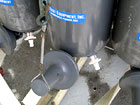

 | ||||||||||||||||||||||||||||||||||||||||||||||||||||
|
|
Journals 2005/2006Denis Costello
July 6, 2005 I'm Denis Costello, a high school teacher from Torrance, California. I am participating in the ECOHAB-PNW Project as a member of the University of Rhode Island's ARMADA Project. I will participate not only as a teacher-at-sea, but also as a scientist. I have previous research cruise experience. Last summer, I contributed to the SEEDS-II project in the Northwest subarctic Pacific Ocean, off the coast of the Kamchatka peninsula. The goal of that cruise was to monitor the sequestration of atmospheric carbon dioxide after the addition of acidified iron. I was invited on that cruise by my former undergraduate professor at the University of Southern California, Dr. William Cochlan, now at San Francisco State University. Dr. Cochlan along with Dr. Vera Trainer (NOAA) invited me to apply to the ARMADA Project and join them on the ECOHAB-PNW Project. ECOHAB is a five-year, multidisciplinary research project that aims to better understand the ecology of harmful algal blooms (HABs) along the Pacific Northwest. This cruise will be the fourth of five cruises with the final cruise taking place in September of this year. The HAB that we are interested in involves Pseudo-nitzschia australis, a diatom that has previously affected the coast of the Pacific Northwest, as well as California. Psuedo-nitzschia is known to produce a neurotoxin called domoic acid (DA), that when taken in by shellfish such as clams, can lead to poisoning in sea lions and humans if transferred through the food chain. This is of great concern in the Pacific Northwest due to the popularity of razor clams and their consumption by people that take them.
I arrived aboard the R/V Atlantis around 8:30 this morning. Most of the equipment had been loaded the previous day by the ship's crew. I spent the first half hour locating my cabin and stowing away my belongings. I then got the opportunity to meet the people that I will be working with. There are groups from several institutions: Dr. Cochlan's group (with whom I would mostly work with) from San Francisco State University, Dr. Charles Trick's group (University of Western Ontario), Dr. Vera Trainer's group (NOAA-Northwest Fisheries Science Center), Dr. Mark Wells' group (University of Maine), Dr. Evelyn Lessard's group (University of Washington) and Dr. Barbara Hickey's group (University of Washington). Dr. Hickey will also serve as the chief scientist of the cruise as she had previously done on the three previous ECOHAB cruises. The day consisted of mainly assisting the science crew build benches and set up equipment before we head out to sea. I used my previous SEEDS research experience to set up the filtration racks and help set up the radiation van (rad-van). The rad-van is located on the third deck, forward of the bridge. It was hard enough to try and build shelves in this room; I couldn't imagine what it would be like to work in there while at sea. This is where experiments with radioisotopes will take place. Liza McClintock (UWO), Maureen Auro (SFSU), Julia Betts (SFSU), Dr. Cochlan (SFSU) and Keri Baugh (NOAA) will work in the rad-van. After unpacking our instruments and setting up the lab, we cleaned up and decided to hit the town for dinner. It would be our last time to eat outside the ship. I grabbed a quick bite to eat with Julia, Maureen and James Falkner (UW), my cabin mate and then went to bed. We expect to depart by 9am tomorrow morning. PARTICIPATING GROUPS ON ECOHAB-PNW IV CRUISE
*left Atlantis on July 16th. #boarded Atlantis on July 16th.
My primary responsibilities for the first ten days of the cruise will be to assist in the deployment and recovery of the CTD, take nutrient and chlorophyll samples, filter the samples for chlorophyll analysis and read the samples (20-24 hours after filtration) for fluorescence. These values will then be plugged in to determine the amount of chlorophyll present in the water. My work will be used to verify the satellite images and to fill in the gaps missed when satellite imagery is obscured by cloudy conditions. My watch will take place between 6 am to 6 pm, although we all expect to put in "overtime."
The CTD is a large sampling apparatus that when deployed, can measure several properties within the water column (salinity, conductivity, temperature, density, fluorescence and chlorophyll levels). The CTD surrounded by a "rosette" of Niskin bottles which can be triggered by an on-deck computer for multi-depth sampling. I have experience handling the CTD from my previous sea experience last summer.
After a CTD is cast, I will take samples from specific depths. I will then take each sample and filter them by using Glass Fiber Filters (GF/F) and 5-mm polycarbonate filters (5-microns). I will use two different types of filters to size fractionate the samples. After the samples are filtered, the filters will be placed into glass test tubes and placed into a freezer for at least 18 hours. After that time has passed, the samples will be placed into a fluorometer, a device that measures the fluorescence of a sample. The data acquired from these readings will then be plugged into a spreadsheet program to determine the chlorophyll content for each sample. |
|||||||||||||||||||||||||||||||||||||||||||||||||||




